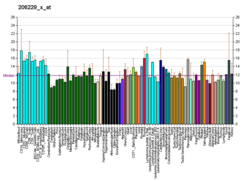PAX2
Paired box gene 2, also known as PAX2 is a protein which in humans is encoded by the PAX2 gene.
The Pax Genes, or Paired-Box Containing Genes, play important roles in the development and proliferation of multiple cell lines, development of organs, and development and organization of the central nervous system. The transcription factor gene Pax2 is important in the regionalized embryological development of the central nervous system. In mammals, the brain is developed in three regions: the forebrain, midbrain, and the hindbrain. Concentration gradients of fibroblast growth factor 8 (FGF8) and Wingless-Type MMTV Integration Site Family, Member 1 (Wnt1) control expression of Pax2 during development of the Mesencephalon, or midbrain. Similar patterning during embryological development can be observed in “basal chordates or ascidians,” in which organization of the central nervous system in ascidian larvae are also controlled by fibroblast growth factor genes. The Pax2 gene encodes for the transcription factor which appears to be essential in the organization of the midbrain and hindbrain regions, and at the earliest can be detected on either side of the sulcus limitans, which separates motor and sensory nerve nuclei.
...
Wikipedia







